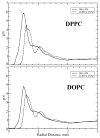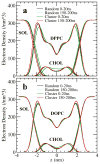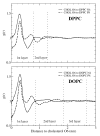Instability of cholesterol clusters in lipid bilayers and the cholesterol's Umbrella effect
- PMID: 20041657
- PMCID: PMC2818971
- DOI: 10.1021/jp909061h
Instability of cholesterol clusters in lipid bilayers and the cholesterol's Umbrella effect
Abstract
The instability of cholesterol clusters and the Umbrella effect of cholesterol in dipalmitoylphosphatidylcholine (DPPC) and dioleoylphosphatidylcholine (DOPC) lipid bilayers were investigated via atomistic molecular dynamics (MD) simulation. Cholesterol clusters in phosphatidylcholine (PC) bilayers are found to be very unstable and to readily disperse into cholesterol monomers. This instability results from the difficulty of the bilayer system in preventing water exposure to cholesterol's bulky hydrophobic bodies in a cluster. The system responds to artificially arranged cholesterol clusters in several interesting manners: (i) cholesterol clusters quickly form a "frustum" shape to reduce water penetration between cholesterol headgroups; (ii) many clusters bury themselves deeper into the bilayer interior, causing bilayer deformation; and (iii) cholesterol fluctuates rapidly, both laterally and vertically, to escape clusters. These fluctuations result in the disintegration of clusters and, in one incidence, a highly unusual flip-flop event of cholesterol across the DOPC bilayer. Our results show that cholesterols have a strong tendency to avoid forming clusters in lipid bilayers and that the fundamental cholesterol-cholesterol interaction is unfavorable. Furthermore, the radial distribution functions of cholesterol hydroxyl oxygen to various headgroup atoms of PC reveal that the PC headgroups surrounding cholesterol have a clear tendency to reorient and to extend toward cholesterol. This reorientation has a layered structure that extends 2-3 nm from the cholesterol molecule. This study demonstrates that the Umbrella hypothesis is valid in both saturated and unsaturated lipid bilayers.
Figures








Similar articles
-
Cholesterol Flip-Flop in Heterogeneous Membranes.J Chem Theory Comput. 2019 Mar 12;15(3):2064-2070. doi: 10.1021/acs.jctc.8b00933. Epub 2019 Feb 4. J Chem Theory Comput. 2019. PMID: 30633868
-
Understanding Miltefosine-Membrane Interactions Using Molecular Dynamics Simulations.Langmuir. 2015 Apr 21;31(15):4503-12. doi: 10.1021/acs.langmuir.5b00178. Epub 2015 Apr 7. Langmuir. 2015. PMID: 25819781
-
A molecular view of the cholesterol condensing effect in DOPC lipid bilayers.J Phys Chem B. 2010 Jun 10;114(22):7516-23. doi: 10.1021/jp101415g. J Phys Chem B. 2010. PMID: 20469902 Free PMC article.
-
Spatially Resolving the Condensing Effect of Cholesterol in Lipid Bilayers.Biophys J. 2018 Dec 4;115(11):2179-2188. doi: 10.1016/j.bpj.2018.10.024. Epub 2018 Nov 2. Biophys J. 2018. PMID: 30447996 Free PMC article.
-
Cholesterol's location in lipid bilayers.Chem Phys Lipids. 2016 Sep;199:17-25. doi: 10.1016/j.chemphyslip.2016.04.001. Epub 2016 Apr 4. Chem Phys Lipids. 2016. PMID: 27056099 Review.
Cited by
-
The interaction between amyloid-β peptides and anionic lipid membranes containing cholesterol and melatonin.PLoS One. 2014 Jun 10;9(6):e99124. doi: 10.1371/journal.pone.0099124. eCollection 2014. PLoS One. 2014. PMID: 24915524 Free PMC article.
-
Towards a Unitary Hypothesis of Alzheimer's Disease Pathogenesis.J Alzheimers Dis. 2024;98(4):1243-1275. doi: 10.3233/JAD-231318. J Alzheimers Dis. 2024. PMID: 38578892 Free PMC article.
-
Posttranslational modifications optimize the ability of SARS-CoV-2 spike for effective interaction with host cell receptors.Proc Natl Acad Sci U S A. 2022 Jul 12;119(28):e2119761119. doi: 10.1073/pnas.2119761119. Epub 2022 Jun 23. Proc Natl Acad Sci U S A. 2022. PMID: 35737823 Free PMC article.
-
Stereospecific Interactions of Cholesterol in a Model Cell Membrane: Implications for the Membrane Dipole Potential.J Membr Biol. 2018 Jun;251(3):507-519. doi: 10.1007/s00232-018-0016-0. Epub 2018 Jan 30. J Membr Biol. 2018. PMID: 29383401
-
Key molecular requirements for raft formation in lipid/cholesterol membranes.PLoS One. 2014 Feb 3;9(2):e87369. doi: 10.1371/journal.pone.0087369. eCollection 2014. PLoS One. 2014. PMID: 24498317 Free PMC article.
References
-
- Somerharju P, Virtanen JA, Cheng KH, Hermansson M. Biochim Biophys Acta. 2009;1788:12. - PubMed
Publication types
MeSH terms
Substances
Grants and funding
LinkOut - more resources
Full Text Sources
Medical

